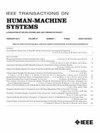与力量训练相关的双变量表面肌电信号的改进复合高斯模型
IF 4.4
3区 计算机科学
Q2 COMPUTER SCIENCE, ARTIFICIAL INTELLIGENCE
引用次数: 0
摘要
最近的文献表明,表面肌电图(sEMG)信号具有非平稳的统计特征,特别是由于协方差的随机性。因此,表面肌电信号统计模型的适用性取决于选择合适的模型来描述协方差。本研究的目的是提出多元表肌电信号的复合高斯(CG)模型,其中协方差的潜在变量被建模为遵循指数模型的随机变量。采用迭代期望最大化算法对模型参数进行估计。此外,还开发了一个新的数据集——肌电图分析人类活动数据库2 (EMAHA-DB2)。通过定性和定量方法对所提出的模型进行了评价。通过对EMAHA-DB2表面肌电信号的模型拟合分析,发现本文提出的CG模型比现有模型更接近表面肌电信号的经验特征。此外,还对不同情景下的模型和估计参数进行了统计分析。指数模型的速率参数的估计与训练权重有明确的关系,可能与潜在的运动单元活动相关。最后,通道的平均信号功率估计显示出对训练权重、受试者的训练经验和活动类型的独特依赖。本文章由计算机程序翻译,如有差异,请以英文原文为准。
An Improved Compound Gaussian Model for Bivariate Surface EMG Signals Related to Strength Training
Recent literature suggests that the surface electromyography (sEMG) signals have nonstationary statistical characteristics, specifically due to the random nature of the covariance. Thus, the suitability of a statistical model for sEMG signals is determined by the choice of an appropriate model for describing the covariance. The purpose of this study is to propose a compound-Gaussian (CG) model for multivariate sEMG signals in which the latent variable of covariance is modeled as a random variable that follows an exponential model. The parameters of the model are estimated using the iterative expectation maximization (EM) algorithm. Further, a new dataset, electromyography analysis of human activities database 2 (EMAHA-DB2), is developed. The proposed model is evaluated through both qualitative and quantitative methods. Based on the model fitting analysis on the sEMG signals from EMAHA-DB2, it is found that the proposed CG model fits more closely to the empirical pdf of sEMG signals than the existing models. In addition, statistical analyses are carried out among the models and estimated parameters under different scenarios. The estimate of the exponential model's rate parameter exhibits a clear relationship with training weights, potentially correlating with underlying motor unit activity. Finally, the average signal power estimates of the channels show distinctive dependency on the training weights, the subject's training experience, and the type of activity.
求助全文
通过发布文献求助,成功后即可免费获取论文全文。
去求助
来源期刊

IEEE Transactions on Human-Machine Systems
COMPUTER SCIENCE, ARTIFICIAL INTELLIGENCE-COMPUTER SCIENCE, CYBERNETICS
CiteScore
7.10
自引率
11.10%
发文量
136
期刊介绍:
The scope of the IEEE Transactions on Human-Machine Systems includes the fields of human machine systems. It covers human systems and human organizational interactions including cognitive ergonomics, system test and evaluation, and human information processing concerns in systems and organizations.
 求助内容:
求助内容: 应助结果提醒方式:
应助结果提醒方式:


